IT’S A COOL MAY MORNING along Sheffield’s busy Chesterfield Road, and Catherine Nuttgens is talking trees with neighbors in the local coffee shop, Mandala. The calm, colorful interior offers a Zenlike respite from the unrelenting street noise outside.
“We’re looking at the Tree Equity project for the United Kingdom, and I think people get it that trees are good,” Nuttgens says to the nodding approval of the group. “I think there’s a real appetite for it here.”

Photo Credit: Paul Rogers / American Forests
Lorraine Dixon, who owns an art supplies store on the same street, emphasizes the relative lack of trees along Chesterfield Road. “We went to Endcliffe Park, and I just touched a tree and said, ‘look at the size of this and how beautiful it is,’” she says with a laugh. “And just that moment was amazing. Can we have a bit of that here?”
Sheffield is full of trees and parks, but they are not equally distributed throughout the city due to historical, societal and economic reasons. On busy streets like Chesterfield Road, it’s mostly because of traffic regulations and infrastructure, such as gas and electric lines, that crowd the narrow sidewalks. In other parts of the city, it’s due to historic barriers such as economics, employment and even community resistance. This is why Nuttgens is leading the Woodland Trust’s collaboration with American Forests and the U.K.’s Centre for Sustainable Healthcare to bring American Forests’ Tree Equity Score to England, Scotland, Wales and Northern Ireland.
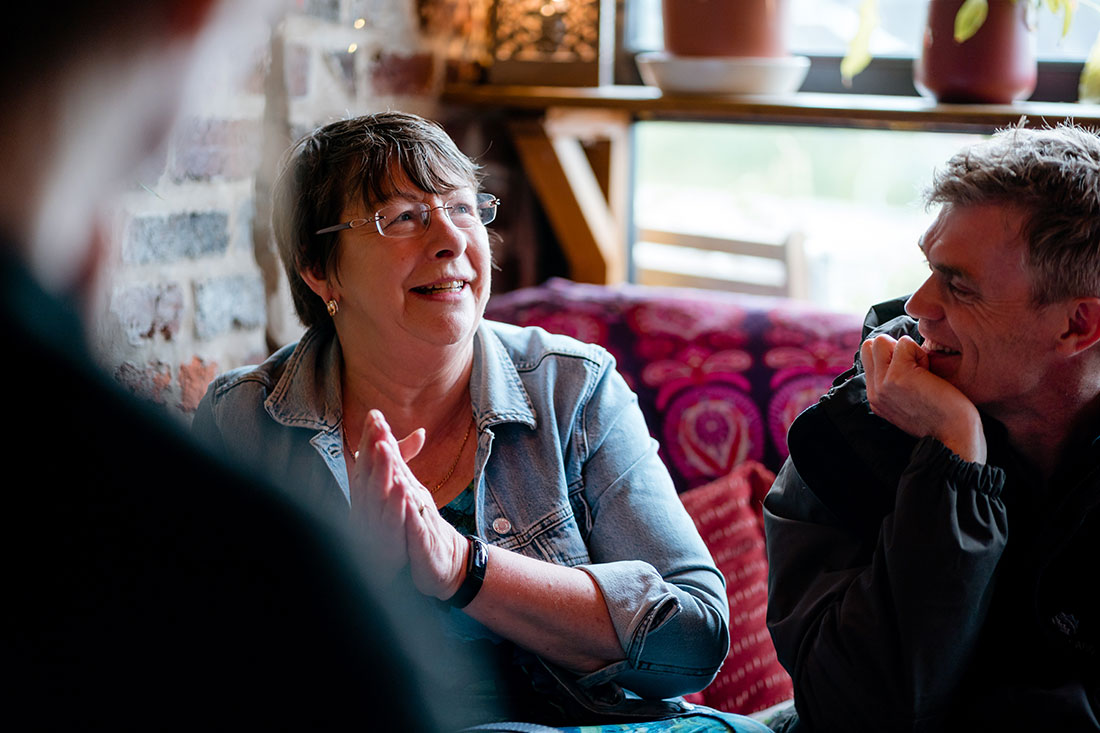
Photo Credit: Paul Rogers / American Forests
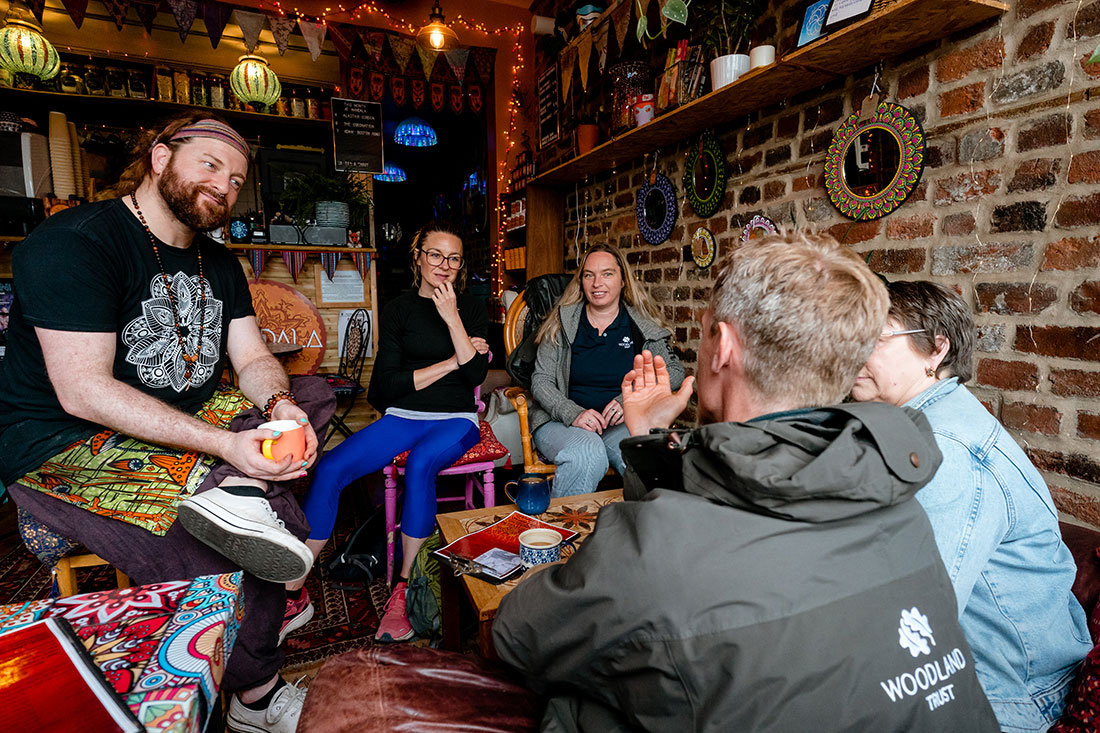
Photo Credit: Paul Rogers / American Forests
LAYING THE FOUNDATION
The first goal of the collaboration is to create a Tree Equity Score for the U.K. that will be plugged into an application similar to American Forests’ Tree Equity National Explorer. This will allow users to see detailed information about the scores for any city or town in the U.K., which will help them plan where to put new trees and how to manage existing trees.
The work “will help illustrate where the resources for trees really need to be,” says Nuttgens. “Not just for planting, but also for better management of trees, for more community involvement in trees, and more resources and funds to help boost involvement with trees in those cities and towns.”
The U.K.’s Tree Equity Score will employ a new methodology and equation, which will differ from the one that has been so successful in the United States. The difference is due to discrepancies in datasets between the U.S. and U.K., as well as differences in the context of the equity challenge in the U.K. The U.K. score will measure a variety of factors within a neighborhood, such as existing tree canopy, income, age, employment, surface temperature and health. This information will primarily come from census data.
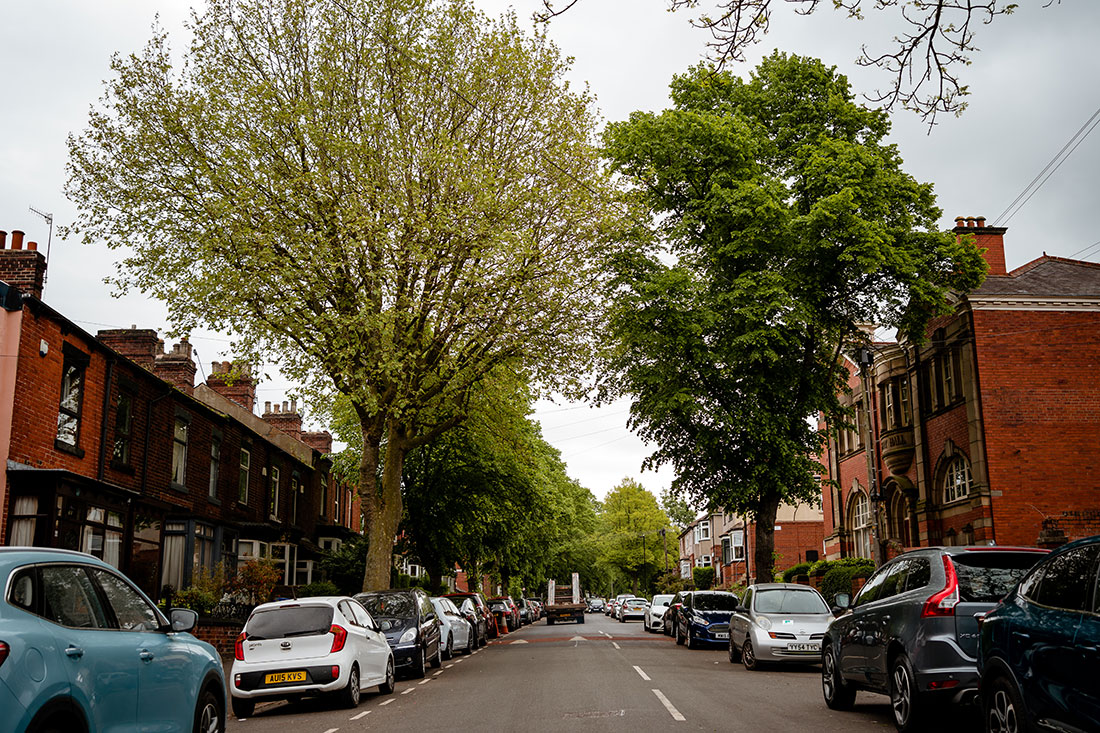
Photo Credit: Paul Rogers / American Forests
It’s worth suspending those Downton Abbey images of manors set amid vast, rolling countryside. Instead, note that the U.K. has a much higher population density than the U.S. It is the 52nd most densely populated country in the world, while the U.S. is 178th. Cities and towns are much closer together, have developed over hundreds of years, and have seen a largely agrarian society morph into industrial and post- industrial economies. This was especially true in Sheffield, which went from a city of villages in the 1700s to an industrial powerhouse over the next 200 years. It also explains why trees are so prevalent here, as former hunting estates were handed over to the city to serve as an escape from the grind of city life, Nuttgens says.
Densely populated small streets, laid out over a thousand years or more, with no U.S.-style grid layouts and large civic spaces are a big challenge, says Adam Cormack, head of campaigning for the Woodland Trust. “That’s where we’re hoping the idea of Tree Equity will help, really. It’s a new, much stronger case for investing the resources necessary to get trees everywhere they’re needed.”
Cormack adds that in the U.K. while the average urban tree canopy cover is around 17%, in some places it is as low as 5%, well below the government’s recommended minimum target of 20%.
Mushtaaq Ali, senior manager of GIS and data science at American Forests, is analyzing and implementing the data and mapping tool for the project. She says the baseline for tree canopy will be lower in the U.K. targets than the U.S. ones due to the differing datasets and ecological conditions between the two countries.

Photo Credit: Paul Rogers / American Forests
The U.K. Tree Equity Score will lean heavily on England’s Index of Multiple Deprivation, which ranks all small areas throughout the country from least deprived to most deprived. The seven indices are income, employment, education, health, crime, barriers to housing and services, and living environment.
Miriam Dobson, who leads on trees and woodlands for the Centre for Sustainable Healthcare, explains why her organization is a partner in the project: “We know that trees have a huge positive impact on people’s health and well-being. But also, the areas with the lowest health outcomes and greatest risks of health deprivation are the areas that also experienced the least Tree Equity and the lowest tree canopy cover.”
CONFLICT LEADS TO COOPERATION
Back at Mandala, owner Adam Heyes is switching between making coffee and weighing in on the discussion. Bearded, beaded and charismatic, he moved here in 2003 and was amazed at the diversity and the tree cover. Heyes often chats with locals and his café patrons about the myriad benefits trees could provide if more were planted in the areas currently lacking canopy.
“I’ve had conversations about people’s mental health and the positive impacts having more trees around here, especially on the roads, could have for me not just as a café owner…but also for the benefit of everyone passing by,” he says.” You can never have too many trees!”

Photo Credit: Paul Rogers / American Forests
Sheffield residents have been pushing for more trees along busy streetscapes and also to preserve the trees already there. It’s been an ongoing issue for the city, one that came to a head in protests between 2014 and 2018, which pitted the City Council and some business owners against a determined group of activists and residents. At issue were plans by the City Council to fell thousands of healthy trees for street improvements, such as highway upgrades, pavement replacement and renewal of streetlights. The protests culminated with the 2021 Sheffield Street Tree Partnership Strategy agreed to by the City Council, environmental groups such as the Woodland Trust, campaigners and residents.
Nuttgens believes these “Tree Wars” ultimately helped usher in an era of a more cooperative approach to tree conservation, and Tree Equity is one way to help deliver it.
Sheffield has a proud history as the steel manufacturing hub of the U.K. — the Pittsburgh across the Pond, some might say. The impact of the decline of that industry in the 1970s and ‘80s on Sheffielders was famously captured in the 1997 global hit movie “The Full Monty.”
However, Nuttgens notes that Sheffield has an equally proud reputation as the U.K.’s “City of Trees,” with more trees per capita than any other city in Europe. And while those trees are spread out across the city — including the hilltop community of Gleadless Valley, where massive, multi-story public housing buildings look out over dense, deep green forests and the city beyond — there are still notable gaps in tree cover, especially along thoroughfares.
“That’s one of my favorite things about [Sheffield] — the trees,” Heyes says. “What is a shame is when you see the big, long roads, and they are the main ways in out of places, and they just don’t have that.”
LISTENING TO THE CHILDREN
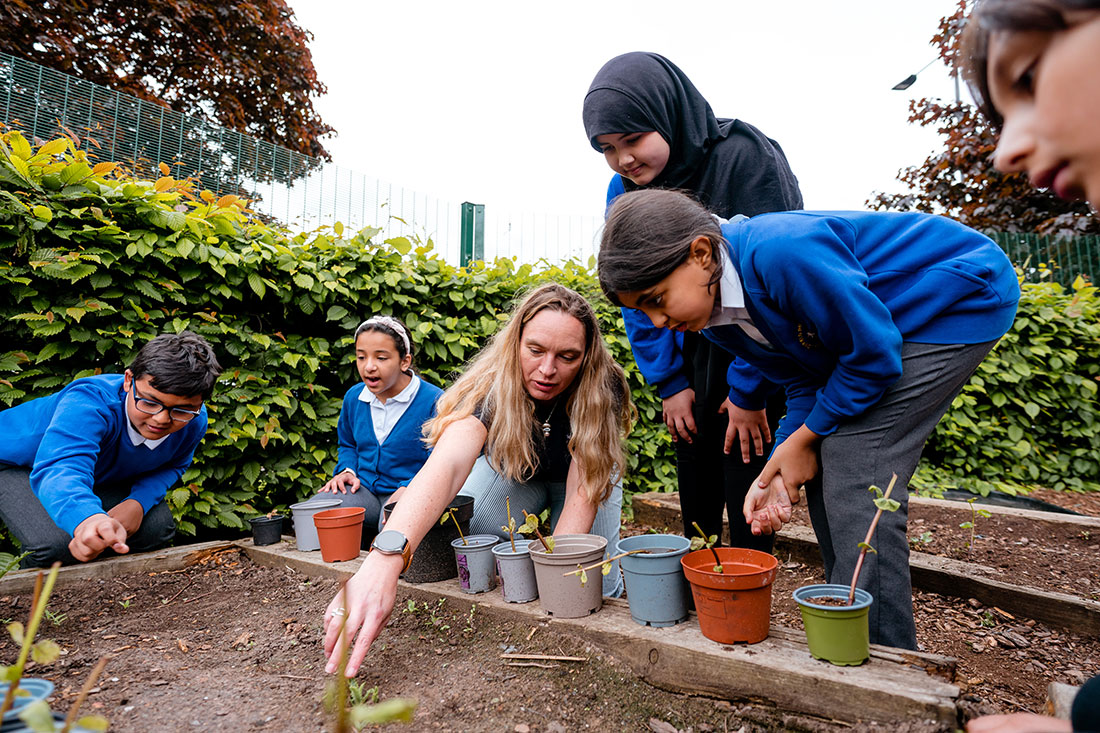
Half a mile up the street from Mandala is Lowfield Primary School, sandwiched between two very busy roads. Built in the 1870s, it has 400 students who speak more than 40 languages and hail from around the world. A number of the pupils are refugees, including some fleeing the war in Ukraine.
It’s also one of the most polluted schools in the city.
As Nuttgens prods the students with questions, they politely and energetically tell her how much trees mean to them. She asks what they hear when they are outside in the playground. “Cars!” they answer almost in unison. She asks them to close their eyes and imagine how they would feel if their playground had more trees in it. “Calm, peaceful, relaxed and quiet,” they say, along with “you feel like you’re in a better environment.”
Lowfield is working with the Green Fences Project, which helps schools develop green barriers by planting more trees between the students and the road. “It’s not going to solve the whole problem, but it’s different ways of trying to organically tackle it,” says Jo Quinlen, safeguarding liaison officer for Lowfield.
Arbourthorne Community Primary School doesn’t have the same pollution and traffic issues that Lowfield experiences. Located on a scenic hilltop southeast of the city center, it does, however, have one of the country’s lowest measures in terms of the multiple deprivation index. In a neighborhood that has lost many of its trees, the school is somewhat of an oasis, with a huge playing field surrounded by trees and plants that would be the envy of any school.
Visitors are greeted outside by an impressive metallic wall sculpture of a flowing tree and inside by a lively educational display about trees and their seeds. Eleven-year-old Gedeon points to the lack of trees in his neighborhood versus here at school. “I’m hoping to see more trees because I don’t see a lot of trees that much anymore in my area,” he says. Nuttgens notes how Gedeon’s neighborhood could be a focal area for Tree Equity investment.
In the meantime, the students are making the most of what they have by planting trees, plants and vegetables on the school grounds, and learning as much as they can about the importance of trees. Nine-year-old aspiring dentist Hyawqal, clad in a shirt reading “Love Our World” and red hairbow festooned with hearts, eloquently summarizes what the project means to her: “Imagine living without any trees and no, like, green atmospheres around you. You’d just feel really dull inside because there’s no color.” Hyawqal recently won a competition by writing a poem about the beauty of trees and how happy they make people.

Photo Credit: Paul Rogers / American Forests
Stella Bolam works with Arbourthorne on planting projects. She is the community forestry project development officer for Sheffield City Council, whose role is to plant and establish trees on public land for schools, community groups and others.
One priority of her work is planting in areas of low tree cover, while another is negotiating with community members who don’t want trees. Opponents to tree planting have a variety of motivations, including the fear of trees falling or blocking light, and a belief that what’s being planted is the wrong species or in the wrong location.
“I think a lot of people don’t feel connected to nature, and I find that really sad because I’ve recently reconnected with nature a bit later in life,” she says. “I get so much out of it.”
She works with residents to let them know the multiple health and environmental benefits of trees. She also coordinates plantings with people who have mental health issues. “Afterwards, they feel really good because they feel like they’ve done something that’s meaningful, and they’ve done it with people around them,” she says. “So I think that’s all part of what we do. It’s not just about trees. It’s about helping people.”
BEYOND THE U.K.’S SHORES, TREE EQUITY’S FAR-REACHING INFLUENCE
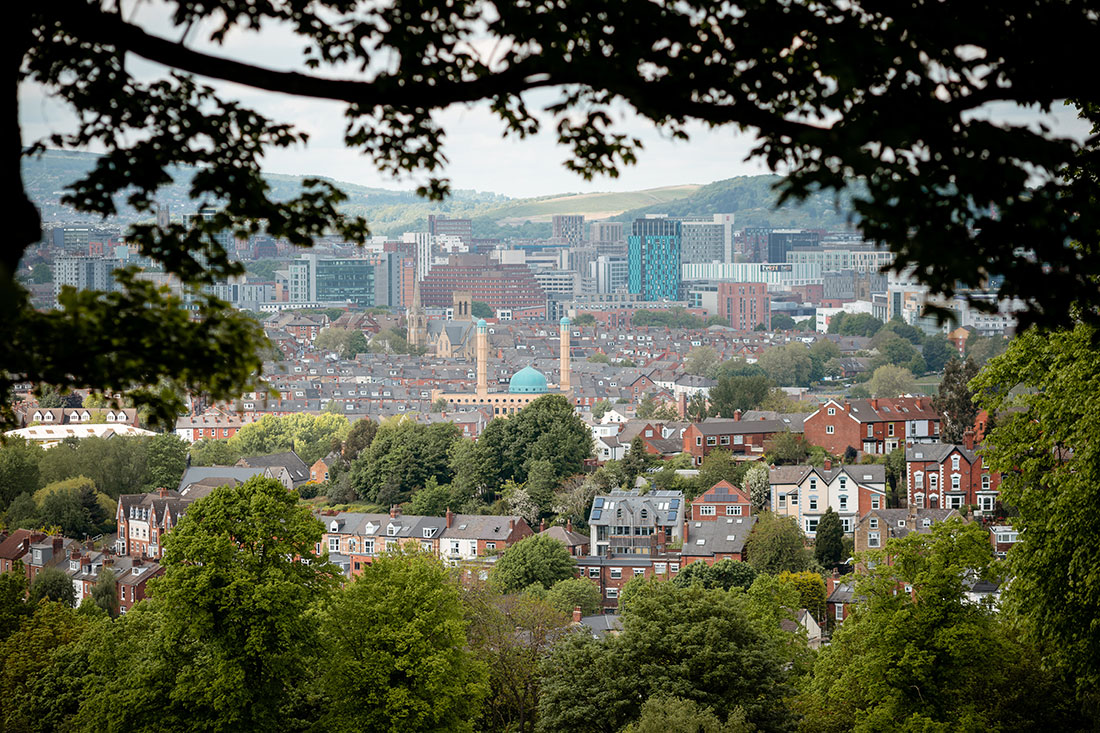
Photo Credit: Paul Rogers / American Forests
Chris David, vice president of GIS and data science at American Forests, says the initial indications from the U.K. project are encouraging:
“The mission that we have at American Forests is applicable anywhere, and the goals of Tree Equity are to catalyze more investment in the places that need it the most. We want to democratize data — the information that people who care about these issues need — and to make that information available to them.”
— CHRIS DAVID, VICE PRESIDENT OF GIS AND DATA SCIENCE, AMERICAN FORESTS
Successfully doing so in the U.K. buttresses the idea that the Tree Equity model can be adapted in other countries, and that the main challenges are differences in census data and data collection in general.
While his team is not currently working with other international partners on a similar scale, David says they have been approached by numerous countries about expanding. The team is open to the idea and is setting up the technology so that it’s possible to do this work in other parts of the world.
“We’re seeing the staying power of Tree Equity Score, and how it has been a way to capture the imagination of people, not just around the country, but around the globe,” he says. “It’s more than a map. It’s a tool for action.”
Lee Poston is a native of Wolverhampton, U.K., who now lives in University Park, Md., where he writes about conservation issues and advises mission-driven organizations.